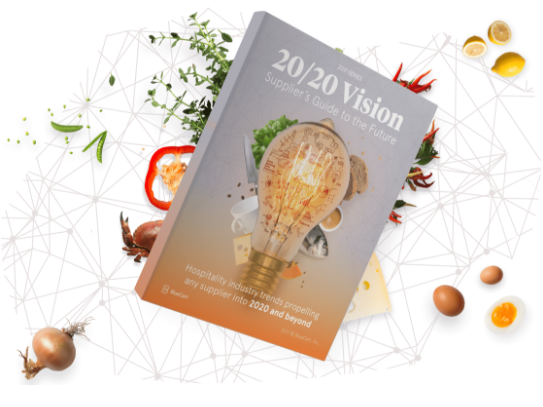Ellie Bradley, Fresh Cup‘s editor, contributed a chapter to Blue Cart‘s 2017 eBook, titled 20/20 Vision: The Supplier’s Guide to the Future. The eBook, available for download here, features eleven chapters of expertise including how millennials are affecting your business, the recent surge in labor automation, and everything in between. Ellie’s chapter focuses on where coffee and technology meet.
[T]he coffee industry has transformed dramatically in the last fifty years; once a beverage largely consumed in the home, coffee is a central driver behind community gathering places. Technology’s influence can be seen all along the supply chain, from better farming practices in coffee-producing countries, to automated systems in cafés. As consumers become more attuned to the taste and quality of coffee, tech-savvy innovations will continue to influence how café owners run business on both sides of the counter.
Goodbye Lines
The way customers order coffee has already changed, and will continue to evolve. Online ordering, subscription services, and delivery options all challenge the traditional queue. With the advent of mobile point-of-service systems, baristas are no longer tied to the counter, opening the door for dynamic service models.
A mobile POS—typically a smart tablet—allows a café to better respond to the flow of customers. If a line builds up during a morning rush, a barista can walk down the line and take orders with a second tablet, cutting down the wait time and improving the customer experience.
Mobile options are also changing the traditional model of café service. More cafés are choosing to use an “order first, pay later” model, where customers are served while sitting at a counter or table, prioritizing service and customer interaction.
Repeatable Results
Good baristas have spent months—often years—honing their skills behind bar. But even a team of highly trained baristas will demonstrate inconsistency during preparation across the group, simply because so many of the steps in drink preparation still rely on manual control. As coffee businesses see continued growth, it will become imperative to find solutions for mitigating variation between baristas.
New tools continue to appear on the market as a solution to this inconsistency: automated tampers, espresso machines with built-in scales and countless options for controlling espresso extraction parameters, and pour-over stands with controlled pulses. These tools perform consistently in high-volume businesses, and allow for repeatable results. Knowledgeable baristas are still very much needed, but automated tools will continue to hit the market, expanding the options for producing a high-quality product.
Closing the Gap to Origin
One of coffee’s greatest challenges is helping consumers understand how coffee is produced. Increasing awareness around the coffee supply chain increases the likelihood consumers will pay more for coffee, in turn helping farmers earn a better living wage and drawing support to protect the industry’s future. The next five years will show a continued push to grow consumer awareness around coffee farming practices.
Coffee bags have become a popular tool for educating customers on coffee’s origin, providing information about the country and region where a coffee was grown, as well as the farm, the process, the name of the producer, and more. Technology is improving how information is delivered to customers: Savor Brands recently introduced a bag that can be scanned with a smartphone to reveal a video telling coffee’s story from farm to cup for each varietal. These educational tools invite users to go beyond QR codes and engage more directly with the products they consume.
Coffee has been around for hundreds of years, and remains an antiquated industry in many practices–especially those at the farm level. Innovation continues to close the gap between coffee and other agricultural industries, and the next five years promise to be no exception.
—Ellie Bradley is Fresh Cup‘s editor.






